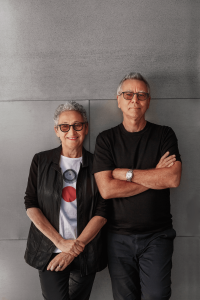The winners of the
Australian Institute of Architects’ Queensland State Architecture Awards have
been announced at the annual Awards night on Friday 14 June.
Following an extensive Regional
Architecture Awards program, 62 unique projects were shortlisted for state
honours, some in multiple categories.
The highlight from this year’s judging was
the exceptional quality of sustainable design principles deployed across the
various projects, demonstrating a strong commitment to human-centred design
that is responsive to the unique and varied climates that exist across
Queensland.
The QUT Creative Industries Precinct 2 by
Richard Kirk Architect and HASSELL Ltd (Architects in Association) has claimed top
honours in three categories – the Jennifer Taylor Award for Educational
Architecture, Don Roderick Award for Heritage and GHM Addison Award for Interior
Architecture.
Incorporating a new six storey building set within the state heritage
listed former Gona Barracks, the precinct was praised by the jury as ‘a world-class example of a creative arts
studies educational building’.
‘Pushing the boundaries of educational architecture, the building is
designed to cross-pollinate the various art disciplines with verandahs flanking
stacked teaching and performing studios, providing a shared experience. Corner
windows to the studios provide views to these spaces, allowing a holistic
engagement with dance, music and fashion, which brings the student work to the
public realm.’
The Harry Marks
Award for Sustainable Architecture went to 25 King by Bates Smart, which also received
the Beatrice Hutton Award for Commercial Architecture.
‘Cited as the
tallest commercial timber building with the largest floor plate in the world,
25 King Street is a potential catalyst for positive change within the
Queensland building design discourse. A restrained glazed rectilinear form of
10 levels with basement belies the importance of the structural resolution
within adopting an all timber structural system, demonstrating a sustainable
and viable alternative to established construction methodologies of steel and
concrete.’
‘This building
illustrates the potential for more sustainable alternative structural systems
to sit confidently within the urban context, catalysing conversations about how
and with what we build,’ the jury said.
The Robin Dods Award for Residential –
Houses (New) was awarded to Bellbird Retreat by Steendijk along with the
Colorbond Award for Steel Architecture.
‘This “off-the-grid”
retreat provides its owners the opportunity to escape and unwind from city life
within a conserved rural setting. Compact in size and function this building is
a highly considered and well-resolved dwelling that has improved the lives of
its owners and their guests. This building is a memorable piece of architecture
at the highest level.’
Queensland Chapter President, Paul Trotter
congratulated winners and entrants for continuing to innovate and create
projects that make a positive impact for those who work, live and play within
them.
‘Architecture has the unique ability to
impact upon people’s lives and create a legacy for future generations, this
year’s award winners can all be proud of that achievement,’ Trotter said.
Projects that
received a Named Award or Award are now in the running for the National
Architecture Awards to be announced in November.
Full list of
winners:
Commercial Architecture
Beatrice Hutton Award – 25 King,
Bates Smart
Commendation – Milani Gallery, Vokes and Peters
Commendation – The Overflow, Loucas Zahos Architects
Commendation – Boundary Hotel, KP Archtiects
Educational Architecture
Jennifer Taylor Award – QUT
Creative Industries Precinct 2, Richard Kirk Architect, Pty Ltd and HASSELL
ltd, (Architects in Association)
Award – Ormiston
College – Centre for learning and Innovation, BSPN Architecture
Award
– James Cook
University – Australian Institute of Tropical Health and Medicine, Thursday Island,
Wilson Architects and Clark and Prince Architects (Architects in Association)
Commendation
– St Andrews Anglican College ‘Learning Hub’, Wilson Architects
Enduring Architecture
Robin Gibson Award – Railton
House and Office, John Railton Architects
Heritage
Don Roderick Award –
QUT Creative Industries Precinct 2, Richard Kirk Architect Pty Ltd and HASSELL
ltd, (Architects in Association)
Interior Architecture
GHM Addison Award – QUT Creative Industries Precinct 2, Richard Kirk Architect Pty Ltd and HASSELL ltd, (Architects in Association)
Award – Aurecon
25 King Workplace, Woods Bagot
Commendation – Level 3, 143 Edward St, Brisbane, m3architecture
Commendation – Allianz Workplace, BVN
Public Architecture
FDG Stanley Award – HOTA
Outdoor Stage, ARM Architects
Commendation: Caboolture GP Super Clinic, Wilson Architects
Commendation – Kawana Waters Aged Care Residence, Deicke Richards
Residential Architecture – Houses (Alterations and Additions)
Elina Mottram Award – Terrarium
House, John Ellway
Award – Albert
Villa, Bureau^Proberts
Award – Teneriffe
House, Vokes and Peters
Residential Architecture – Houses (New)
Robin Dods Award – Bellbird
Retreat, Steendijk
Award – Bramston
Residence, Richard Kirk Architect, Pty Ltd
Award – Mermaid
MultiHouse, Partners Hill with Hogg & Lamb
Award – Indooroopilly House, Owen
Architecture and Lineburg Wang
Commendation – The
Bird Cage, Tim Ditchfield Architects Pty Ltd
Commendation – Princess
St House, Owen Architecture
Commendation – Spinnaker
House, Sparks Architects, Pty Ltd
Commendation – Tierney
Drive House, ME
Commendation – Cove
House, Justin Humphrey Architect
Residential Architecture – Multiple Housing
Job & Froud Award – Walan,
Bureau^Proberts
Award – Longfellow
Terraces, REFRESH*DESIGN
Commendation
– North Residences,
Bureau^Proberts
Commendation
– Student One on Wharf St, Arkhefield
Small Project Architecture
Hayes & Scott Award – Kooroomba
Chapel, Wilson Architects
Sustainable Architecture
Harry Marks Award – 25
King, Bates Smart
Award – Bellbird
Retreat, Steendijk
Commendation – QUT
Creative Industries Precinct 2, Richard Kirk Architect, Pty Ltd and HASSELL
ltd, (Architects in Association)
Commendation – James
Cook University – Australian Institute of Tropical Health and Medicine,
Thursday Island, Wilson Architects and Clark and Prince Architects (Architects
in Association)
Commendation – Caboolture GP Super Clinic, Wilson Architects
Urban Design
Karl Langer Award – 900
Ann Street, Brisbane, John Wardle Architects
COLORBOND® Award for Steel Architecture
Award – Bellbird
Retreat, Steendijk


